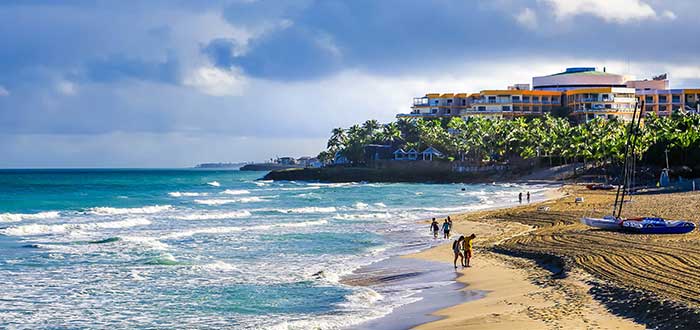
“LA MIGUEL FAILDE”, UNA ORQUESTA CUBANA CON EL APELLIDO DEL DANZÓN. VIDEOS.
La orquesta Miguel Failde, conocida también como orquesta Failde o simplemente La Failde, lleva el nombre del creador del primer danzón dado a conocer al público: ‘Las Alturas de Simpson’, en homenaje a una barriada de esta municipalidad matancera.
Esta pieza se estrenó la noche del primero de enero de 1879 en el Liceo Artístico y Literario, en la actualidad Sala de Conciertos José White, de esta urbe, nombrada la Atenas de Cuba, y desde sus inicios el novedoso ritmo tuvo aceptación entre los bailadores.
https://youtu.be/K6rkqip9U4M
Ahora, 141 años después, el colectivo creado y dirigido por el flautista Ethiel Fernández Failde, da continuidad al legado de su tatarabuelo Miguel, con un formato similar a la charanga típica del siglo XX aunque presenta metales como saxofón, clarinete, trombón y trompetas.
MIGUEL FAILDE, HACIENDO UN POCO DE HISTORIA.
Miguel Failde (1852-1921), hijo del peninsular Cándido Failde, natural de Galicia, y de la “parda libre” Justa Pérez, según consta en el libro tres de bautismos, folio 40, partida 222, que se halla en la iglesia del poblado de Limonar.
Miguel funda, a los 18 años de edad, su orquesta típica con la cual fue reconocido por la sociedad de Matanzas y que en su inicio la integraron: primer violín Pancho Morales, segundo violín Juan Cantero, primer clarinete Anselmo Casalín y segundo clarinete Eduardo Failde.
Miguel Failde tocaba además el contrabajo y la viola y, a pesar de no ser pianista, interpretaba piezas complejas en ese instrumento y se le atribuye, por investigadores, la autoría de unos 144 danzones, además de otras composiciones.
La profesora e instrumentista Victoria Oliver nos recordó que la presencia de inmigrantes franceses y franco–haitianos en Matanzas, provocó la presencia por estos lares de formas de canto y baile como la contradanza francesa.
“Aunque mantiene sus esencias estructurales europeas, y un hacer coreográfico definido para el salón; a su entrada a Cuba ya se encuentra tamizada por la contribución negra adquirida en La Española, o en las tierras sureñas de Norteamérica, es preciso puntualizar que el negro de clase media en Cuba hubo de desempañarse en oficios no requeridos por blancos como el de músico”, señaló.
Oliver precisó que el proceso de gestación del danzón, es un hecho que responde a una evolución histórica dentro de un contexto específico del devenir social.
“LA FAILDE” HOY.
Más de una centuria y cuatro décadas después, Ethiel incorpora a su repertorio danzonero piezas como ‘Almendra’, ‘Monserrate’, ‘Fefita’ y ‘Los ojos de Johanna’, e incluye reconocidos artistas de Cuba como la icónica vocalista Omara Portuondo, y el pianista Alejandro Falcón
“Trabajamos con un lema que reza: Nuevos timbres, sonoridades contemporáneas, revolución del género, sin perder su esencia”, destaca Ethiel, de apenas 29 años de edad y con un amplio futuro en el espectro musical cubano.
“Aspiramos que el danzón se convierta en nuestro baile nacional por el nivel de consumo de ese ritmo, y vislumbramos una música que esté en el lugar que le corresponde”, subraya.
La calidad musical de la orquesta ‘Miguel Failde’, recibió en fecha reciente un reconocimiento por la revista ‘Jazz Wise’, una de las más importantes dedicada al género en Reino Unido.
 “LA MIGUEL FAILDE”, A CUBAN ORCHESTRA WITH THE SURNAME OF THE DANZÓN. VIDEOS.
“LA MIGUEL FAILDE”, A CUBAN ORCHESTRA WITH THE SURNAME OF THE DANZÓN. VIDEOS.
The Miguel Failde orchestra, also known as the Failde orchestra or simply ‘La Failde’, bears the name of the creator of the first danzón released to the public: ‘Las Alturas de Simpson’, in homage to a neighborhood in this Matanzas municipality.
This piece was premiered on the night of January 1, 1879, at the Artistic and Literary Lyceum, currently, the José White Concert Hall, of this city, named the Athens of Cuba, and from its inception, the novel rhythm had acceptance among dancers.
Now, 141 years later, the group created and directed by the flutist Ethiel Fernández Failde, continues the legacy of his great-great-grandfather Miguel, with a format similar to the typical 20th-century charanga although it presents metals such as saxophone, clarinet, trombone, and trumpets.
MIGUEL FAILDE, MAKING A LITTLE HISTORY.
Miguel Failde (1852-1921), son of the peninsular Cándido Failde, a native of Galicia, and of the “free parda” Justa Pérez, as recorded in book three of baptisms, folio 40, item 222, which is found in the church of Limonar town.
Miguel founds, at 18 years of age, his typical orchestra with which he was recognized by the Matanzas society and which at the beginning was made up of first violin Pancho Morales, second violin Juan Cantero, first clarinet Anselmo Casalín and second clarinet Eduardo Failde.
Miguel Failde also played the double bass and viola and, despite not being a pianist, he performed complex pieces on that instrument and is attributed, by researchers, the authorship of some 144 danzones, in addition to other compositions.
The teacher and instrumentalist Victoria Oliver reminded us that the presence of French and Franco-Haitian immigrants in Matanzas caused the presence in these parts of forms of song and dance such as the French quadrille.
“Although it maintains its European structural essences, and a defined choreographic work for the room; Upon entering Cuba, it is already sifted by the black contribution acquired in Hispaniola, or in the southern lands of North America, it is necessary to point out that the middle-class black in Cuba had to perform in trades not required by whites such as musician “, he pointed.
Oliver specified that the danzón gestation process is a fact that responds to a historical evolution within a specific context of social evolution.
More than a century and four decades later, Ethiel incorporates pieces such as ‘Almendra’, ‘Monserrate’, ‘Fefita’ and ‘Los Ojos de Johanna’ into its dance repertoire, and includes renowned Cuban artists such as the iconic vocalist Omara Portuondo, and the pianist Alejandro Falcón.
“We work with a motto that reads: New timbres, contemporary sounds, genre revolution, without losing its essence”, highlights Ethiel, just 29 years old and with a broad future in the Cuban musical spectrum.
“We aspire for the danzón to become our national dance due to the level of consumption of that rhythm, and we envision music that is in its rightful place,” he underlines.
The musical quality of the ‘Miguel Failde’ orchestra recently received recognition from the magazine ‘Jazz Wise’, one of the most important magazines dedicated to the genre in the United Kingdom.
Agencies/ Radio Enciclp/ Extractos/ Excerpts/ Internet Photos/ YouTube/ Arnoldo Varona/ www.TheCubanHistory.com
THE CUBAN HISTORY. HOLLYWOOD.










